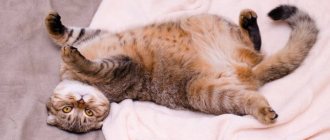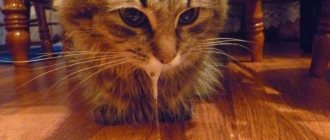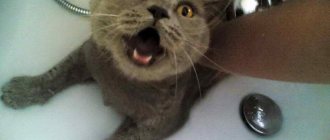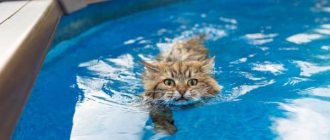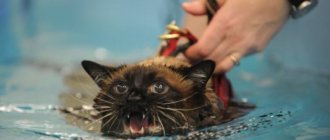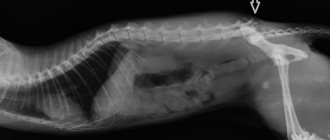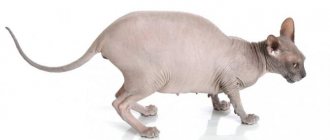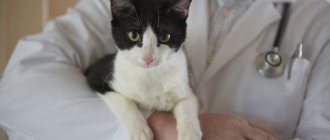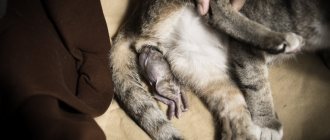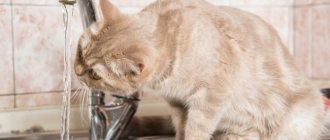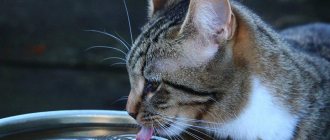Refusal to eat and drink is a protective reaction of the body. Energy is concentrated in the cat's body in the form of fats, which, if necessary, become sources of water and energy.
When 1 g of fat is oxidized, 9.3 kcal is released and 1.06 g of water is synthesized. However, the body’s capabilities are not unlimited and depend on age, physiological characteristics, and health status. How long can a healthy cat live without food? And the sick one? What about the old one? This article answers the questions raised.
Nutrition and fluid standards for cats.
The breeder decides what to feed the cat. There are several food options:
- Dry food.
Cat and dry food
- Wet. They sell bags or so-called pouches of food. This group includes canned cat food.
Wet food
- Combined. This is when they alternate between dry and wet.
- Natural food. There is a certain percentage of breeders who prefer to feed natural food, for example: cottage cheese, cereals, eggs, fish, meat.
Natural food
A cat's daily intake of food and water depends on several factors:
- Age.
As a rule, newborn kittens up to 6 months of age require frequent feeding 3-4 times a day.
Grown-up kittens up to one year old are given food 2-3 times a day.
Adult cats are given food 1-2 times a day.
For older pets who are healthy, once a day is enough.
- Health status.
For example, if a cat has recently given birth to kittens or is in an interesting situation, you should feed more and more often for obvious reasons. Milk should contain as many nutrients and vitamins as possible for newborn babies.
Cat feeding kittens
After operations: castration and sterilization, the menu should be given more attention. Since metabolism slows down, pets are prone to weight gain.
Cat after sterilization
- Breed.
Large breed cats such as Maine Coon, Kurilian Bobtail, Norwegian Forest, and Ragdoll eat more food per day.
Typically, adult cats weigh between 3-5 kg.
If the pet's ribs are visible in a calm state, this indicates that the diet is incorrect and it needs more food.
Now a little about water balance.
There should always be enough fresh drinking water. This is especially true for those cats who consume dry food. The water bowl does not need to be placed next to the bowl where the cat's food is. Put it somewhere else. Our smaller brothers are very smart animals, and often rely on instincts. The fact is that in the wild, a cat does not leave its food near water, for example, near a lake or river, because food tends to rot and decompose.
Have you noticed that cats love to drink tap water?
There is an explanation for this. Pets believe that this water is cleaner than in a bowl because stagnant water is rich in germs and contaminants. Wash food and water bowls regularly, as unfavorable microflora accumulate there.
Cat and water
Lack of water leads to urolithiasis. The kidneys and liver suffer. Therefore, provide your pets with clean drinking water. Better filtered.
What affects the rate of dehydration
Cats are not such whimsical creatures as humans. Even a small puddle can serve as a source of drinking. Therefore, in nature, felines rarely die from its lack. Speaking about home life, sources of drinking can be a dripping faucet, toilet, plants.
It is impossible to say exactly how long a cat can go without water, since individuals can be strong and can withstand up to 10 days.
You can only start from the average value. Therefore, single owners should take care of what will happen in the event of force majeure.
How does hunger affect the body?
Everyone has probably seen stray dogs and cats on the street. Their appearance is often frightening, thin, with protruding bones and sunken eyes.
stray cat
Please note that the digestive systems of dogs and cats are different. Dogs are relatives of wolves and their bodies are adapted to fasting for a large amount of time. But things are different for cats. Felines eat often and in small portions, so when there is a lack of food, the body experiences great stress. It is known that fat is broken down in the liver. If food is not supplied for a long time, the liver will process more fat. And she will no longer cope with such a load. This will give rise to the development of diseases. The kidneys and liver are primarily affected. And if the refusal to eat drags on for a long time, then nutritional dystrophy occurs, in other words, depletion of the body from which all organs, without exception, suffer.
Mr. Cat recommends: how to help
If a pet refuses food for more than two days, then first of all it is necessary to establish the cause of the hunger strike and try to eliminate it, if possible. During this period, it is extremely important to take the following measures:
- Ensure constant access to clean drinking water.
- Try to arouse the animal's appetite by holding a strong-smelling treat to its muzzle.
- Prepare your pet’s favorite dish and heat it to just above room temperature.
- You can try to feed the cat using a teaspoon or from the palm of your hand. A small kitten is given liquid warm food through a syringe without a needle - starvation is especially dangerous for him.
- It is advisable to drop a few drops of a special product into the water that stimulates the appetite of cats. It is sold in veterinary pharmacies.
If all else fails and the hunger strike continues, you should take your pet to a veterinary clinic.
This must be done immediately if:
- refusal to eat for more than two days;
- dry hunger strike - the cat does not eat or drink;
- signs of dehydration are observed - the coat looks oily, the nose is dry and soft, and general lethargy and lethargy are noted.
If a disease is detected and treatment is prescribed, but the animal’s appetite does not return, the cat is forcibly fed (in agreement with the veterinarian) with liquid food - baby meat puree or special medicinal wet mixtures, kefir, fermented baked milk, chicken broth.
We identify the causes of fasting
Refusal to eat does not always signal that your pet is not feeling well.
Sometimes cats fast for 24 hours as a way to fasten their diet. Here are a number of reasons why a cat may refuse food:
- Stress. Losing an owner, moving to another place, meeting other pets, for example, you got another cat or dog.
- Acclimatization. Let's say you took your pet on vacation. Usually the hunger strike lasts no more than 2 days.
- Abrupt transfer from one food to another. Or, for example, introducing a new product into the diet.
- Poisoning.
- Operation. After any surgical medical intervention performed under anesthesia. Animals recover from anesthesia for at least a day.
- Hormonal changes in the body. Estrus, mating, pregnancy, childbirth.
- A hunger strike can be triggered by a tick bite.
- Disease. Lethargy, refusal of food and even water, a common symptom of a hidden disease or inflammatory process.
- Lack of sanitary standards. Dishes and feeding area should always be clean.
- Oral disease. Cats also have tooth and gum pain. Moreover, there may be a foreign object in the mouth, for example, a fish bone. As well as the appearance of cones and formations. Only a doctor can determine whether a tumor is malignant or not.
Cat health problems associated with fasting
A constantly hungry animal exhibits the following negative health problems:
- hair begins to fall out;
- weakness appears;
- liver problems appear;
- The immune system and central nervous system suffer.
Of course, it is not worth leaving an animal in severe conditions of hunger. We must take care of those who are smaller than us, especially when it comes to pets. Of course, sometimes there are situations when fasting cannot be avoided. For example, the postoperative period in a pet or with another illness. As you know, when a pet is sick, it usually does not eat anything, but only drinks water. Thus, microbes and viruses do not multiply in the body and die.
After recovery, the cat needs the right diet and vitamins in order to restore the body. After poisoning, an animal, as a rule, may not eat for up to a week, and then eat in small portions. After a long period of fasting, you should not feed your cat large portions, otherwise the animal may die. Dry food is prohibited during the recovery period.
Consequences of not eating
Here are a few factors that influence the consequences of not eating and drinking:
- Age of the cat;
- Weight;
- Causes and duration of hunger;
- Health status.
But look at the consequences of long-term abstinence from cat food:
- Weight loss.
- Prostration. It is difficult for the cat to get up and move around. If she moves, it is very slowly and not confidently.
- Hair loss, mats.
- Visual acuity is lost.
- Constipation, kidney failure, gastric ulcers.
How long can a cat live without water?
Everyone knows the fact that almost every living thing on the planet consists of water. For example, a person consists of 80% water, but cats are 70%. The average fluid intake for an adult cat is 200-300 ml per day.
Water performs important functions in a cat's body:
- Regulates body temperature.
- Necessary for normal digestion of food.
- Removes toxins from the body.
- Supports Organ Functions
- Ensures the functioning of enzymes.
Several factors influence life expectancy in the absence of water:
- Season. In unbearable heat and stuffiness, cats can live no more than a day, if they are lucky, a day and a half. Accordingly, in the cold season, this period will increase slightly.
Cat in the shadows
- Cat food. If you feed your pet exclusively dry food, dehydration will occur very quickly.
- Breed. For example, British breed cats consume less fluid than other breeds.
Important! For cats, the lack of food is not as critical as the lack of water.
If you are forced to leave your pet alone for several days, provide constant access to water. You can place water in different parts of the apartment. As a last resort, leave the toilet lid open.
Pet stores sell automatic waterers for pets. They will provide regular access to water.
Water bowl for cats
Forget about drinking, just eat
For desert animals, food is often one of the best sources of water, and food can survive when there is no moisture. North American marsupial rats and mice collect seeds when conditions are moist and plants are abundant. They live off these seeds for the rest of the year. These rodents spend hot, dry days in their burrows and only come out at night. Because the seeds they store are high in carbohydrates, rodents gain energy and metabolic water so they don't need to drink.
While rodents rely on carbohydrate metabolism, larger mammals, such as camels and oryxes, rely more on fat metabolism. When an animal breaks down one gram of fat, 1.12 milliliters of water is released. Therefore, camels do not store water in their humps, but fat reserves.
If fat is such a good source of water, you might ask why there aren't huge numbers of animals in the desert that can survive on their own reserves of fat. However, if animals have fat distributed evenly throughout their body, they will also suffer because it is a good insulator that traps body heat. This means that fat deposits should be stored in one or two places on the body.
First aid
If it is not possible to visit a doctor. Or you need a long time to go to the veterinary clinic, then you can try to restore your appetite yourself:
- Older cats lose their sense of smell as they age. Bring the bowl close to your nose.
- Try giving a treat that your cat has never refused.
- Warm up the food, put a small amount in your palm and bring it close to the cat.
- Pet stores sell medications that induce appetite.
When to contact a veterinarian urgently
Prolonged hunger strike is a process that has a significant negative impact on all vital systems of the cat. Thus, it is necessary to highlight the most dangerous conditions. In case of occurrence of which it is necessary to urgently show the animal to a highly qualified doctor:
- If the animal begins to splash out the infused liquid.
- The cat's nose becomes warm and very dry.
- If there is a significant increase in your pet's body temperature.
- Symptoms of diarrhea or vomiting are observed.
- General anger of the body or failure to respond to any signals.
If you notice that your pet has suddenly lost his appetite or is refusing to drink fluids, then you should immediately consult a veterinarian. Only a professional will be able to establish the main cause of this condition and recommend the main ways to eliminate it. If you pay due attention to your pet, its health will be strong and its condition stable.
